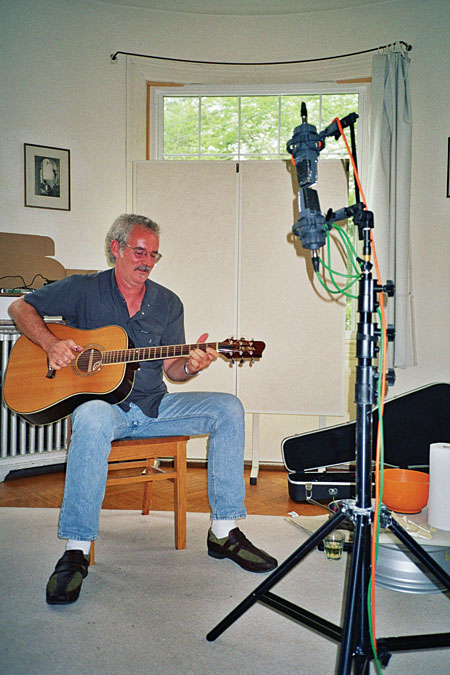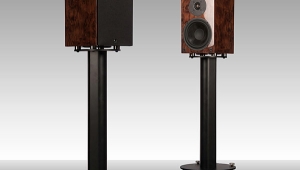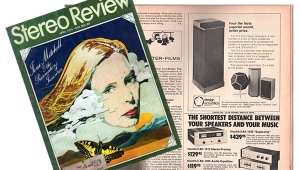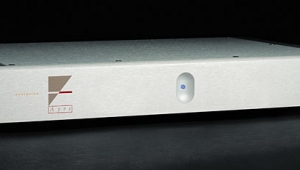| Columns Retired Columns & Blogs |
The Fifth Element #38
The Ultimate Audio Toy—Or, if you will, the apotheosis of the iPod.
Footnote 1: The folks who marketed the Ginsu knife on late-night television filed for bankruptcy in Rhode Island. In the Trustee's Notice of Sale newspaper ad, and in at least one court order, the proceedings were interrupted so that the words "But wait, there's more!" could appear in the middle of the page.
For those of you who can peel off and drop 25 or so $100 bills on what would be, for most of us, a sheer self-indulgence, I can confidently state that the Sound Devices Model 722, a hard-disk–based, high-resolution, portable audio recorder ($2650), is the coolest, most desirable piece of audio hardware I have encountered in a dog's age. Although designed as a rugged, high-performance, foolproof, battery-powered portable stereo recorder for electronic newsgathering (ENG) and video- and film-sound recording (especially nature documentaries), the 722 can also serve as the ultimate personal stereo.

To wit, you can play your precious old vinyl and run the line-level output of your phono stage into the 722's line-level XLR analog inputs, configure the 722's onboard analog-to-digital converters to 24-bit/192kHz, and record 10 hours of higher-than-CD-standard-resolution digital audio onto its internal 40GB hard drive. iTunes be damned.
Then, on a plane or at the beach, you can connect a good pair of stereo headphones and listen using the 722's not-at-all-shabby DACs and headphone amp, at 4x "Red Book" data density. Standard ¼" TRS (tip-ring-sleeve) stereo headphone plugs will require use of the adapter cord Sound Devices includes. This is because real estate is so scarce on the 722's petite chassis (it's the size of a large paperback book) that all the connectors save the XLR mike/line inputs are miniature. Indeed, space is so tight that part of the legend on the slide switch for Input 1 is hidden behind that input's XLR release tab. Not a square millimeter has been wasted.
As Charles Goren often said on his TV show about Bridge, let's review the bidding. Sound Devices' 722 contains two professional mike preamps with 48V phantom power. These inputs are reconfigurable as line inputs. The inputs are routed to the two hard-disk recording tracks in any of 16 possible combinations, either through menu choices or front-panel keystroke shortcuts. The inputs are linkable: one rotary control controls gain for both channels while the other sets balance between them, or each knob controls one channel's gain. Both gain knobs extend and retract from being flush with the front panel, so their settings will be less likely to be accidentally disturbed.
Furthermore, the input channels can be sent through a true cross-fading M-S matrix, in which case the "L-C-R" indicator on the LED screen's main menu becomes "M-*-S." Deeper levels of the menu structure enable low-cut EQ and dynamic limiting settings. So you start off with a high-quality, full-featured professional mike preamp. But wait, there's more! (Footnote 1)
Next up is a 24-bit/192kHz–capable A/D converter. The sample-rate choices are 16 and 24 bits, with redithering from 24 to 16 as another menu option. A stereo AES/EBU digital input can be routed through Channel 1's XLR; otherwise, S/PDIF in and out—on BNC connectors—are on the opposite (right) side of the chassis. Audio data are stored as .WAV or MP3 files (why bother?) on the 40GB hard drive.
Furthermore, the 722 has a FireWire port, allowing it to connect to a computer as a mass storage device, so all its files can be accessed or copied. Or the FireWire port can be used to connect an external hard drive, although I can't imagine needing that much storage. So factor in, too, the value of a high-quality ADC and a data-storage and file-management system.
Monitoring and playback are through an onboard 24/192 DAC and a very robust yet detailed headphone amp. Left and right line-level analog outputs appear on three-pin TA3-M miniature connectors and a mini stereo headphone jack. Factor in all that as well.
Were all that not enough, the 722 has a slot for a Compact Flash (CF) memory card, which can be configured to serve as either backup or reserve/removable recording capacity. The lithium-ion battery included with the 722, a standard Sony professional type, provides about four hours of use. Larger-capacity batteries are available, and a battery charger is included. The charger charges the battery even if the 722 is not powered up, or can charge as it runs. The 722 can also be reconfigured to run off external battery packs through its charging port.
It's not cheap, but, criminy, the 722 sure gives you your money's worth! I can't imagine how they can provide all the functionality they do and charge only $2650 (slight discounts available). Of course, data storage has gotten radically cheaper over the years, as has computing power; one could look at the 722 as a notebook computer that has been customized for audio. But skinning that cat on your own would involve buying a USB mike preamplifier and A/D converter, and either forgoing a few of the 722's mixing capabilities, or buying USB mike preamps and a compact mixer, then an ADC, and then a computer. I can't get that arithmetic to work.
Economics aside, the other area where the 722 comes in ahead of a computer-based solution, in my estimation, is ease of use. Because the 722 was designed with ENG in mind, where the usual job is "run and gun," it is as user-friendly as possible, consistent with its tremendous capabilities. You power up the 722 and it's ready to record a new audio file, date- and time-stamped and titled with a pre-selected scene name. You don't even have to say "Please."

One aspect that might take a bit of getting used to is that, to start recording, all you need do is press Record. Sound Devices has chosen to leave behind the two-button approach to recording still found on most digital recorders: press Record to prepare for recording, then Play to actually do it. That goes back to the old needs to first physically engage the record head against the tape path, and then to get the tape reels spinning. It takes some relearning, but after a while it becomes second nature.
The other reason to do things Sound Devices' way is that you can set the 722 to buffer audio from its inputs into a cache, up to 10 seconds' worth at 44.1kHz (or 5 seconds' worth at 96kHz or 2 seconds' worth at 192kHz). In other words, as long as the 722 is powered up and has signals at its inputs, it is caching the audio, and when Record is pressed, it writes the cache to the hard disk as the beginning of the current sound file—great insurance against clipped starts. But with hours of hard-disk time, even at 24/192, it seems silly not to err on the side of just letting it run in Record mode.
Footnote 1: The folks who marketed the Ginsu knife on late-night television filed for bankruptcy in Rhode Island. In the Trustee's Notice of Sale newspaper ad, and in at least one court order, the proceedings were interrupted so that the words "But wait, there's more!" could appear in the middle of the page.
- Log in or register to post comments




































